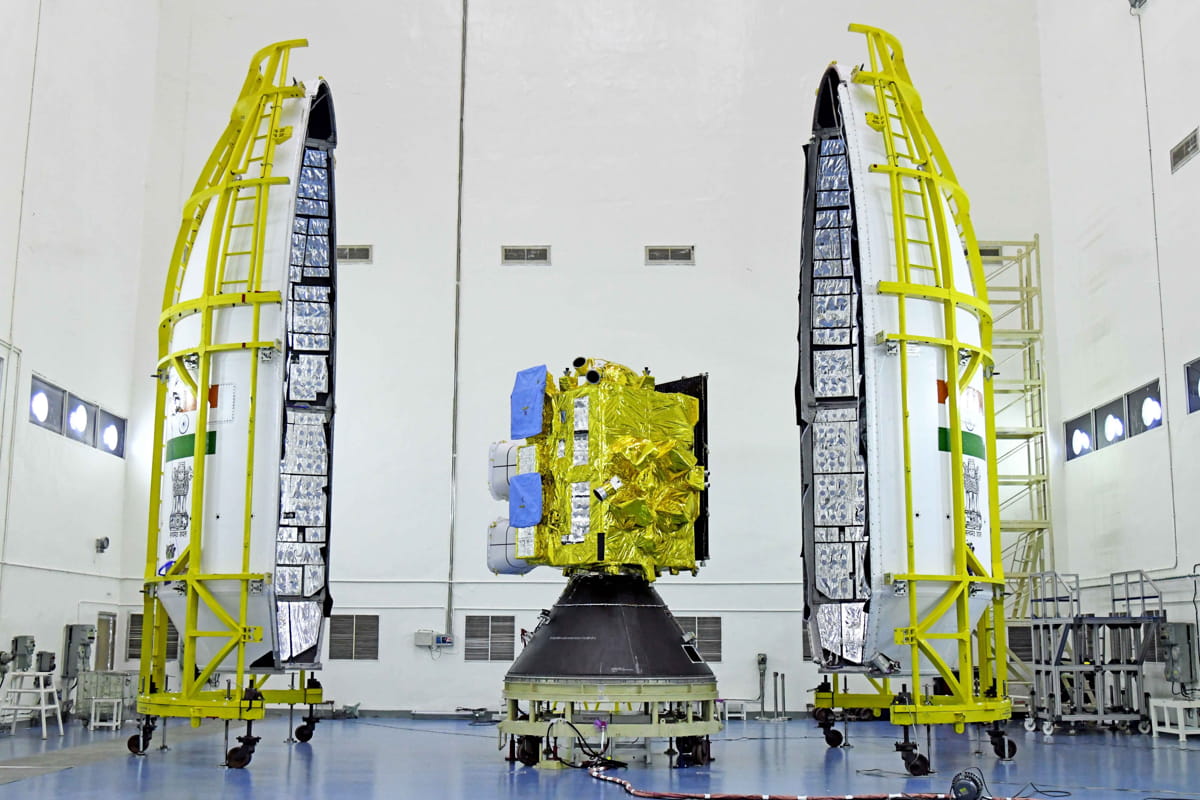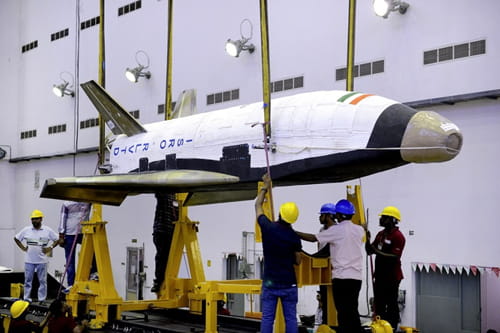
India’s indigenous Geosynchronous Satellite Launch Vehicle (GSLV). | Indian Space Research Organisation.
It is pertinent to note that India’s Department of Space’s vision for India’s space program does not include the development of a heavy-lift rocket as a priority. Given the comparable plans of China and India regarding lunar habitation, the space station and Mars missions, China’s ability to build a super heavy-lift reusable rocket would mean India will have a strategic disadvantage in its long-term lift capacity.
Introduction
On August 23, 2024, India celebrated its first National Space Day on the theme “Touching Lives while Touching the Moon: India's Space Saga” to commemorate the first anniversary of India’s Chandrayaan 3 Lunar mission that landed on the southern hemisphere of the Moon. On India’s first Space Day, certain timelines were reiterated:India’s plans for its human spaceflight mission Gaganyaan (2025), its space station between 2028-2035, the Chandrayaan 4 mission to collect lunar samples and bring it back (2027), the first Indian human mission to the Moon by 2040 and specific plans to build a heavy lift rocket, called Soorya (Next Generation Launch Vehicle-NGLV). The lift capacity of this vehicle will be 30 tons to Low Earth Orbit (LEO) and ten tons to Geosynchronous Transfer Orbit (GTO).
This, if successfully launched by 2035-2040, as specified by Indian Space Research Organization (ISRO) Chairperson S. Somanath, will be crucial to building India’s space station. In terms of comparison, if successfully launched, Soorya will be similar to SpaceX’s Falcon 9 and China’s Long March 5, in terms of lift capacity to LEO and GTO. Falcon 9 is a first-stage reusable rocket.

India’s indigenous Reusable Launch Vehicle – Technology Demonstrator (RLV-TD). | Indian Space Research Organisation.
However, by India’stimeline of 2035-2040 for a heavy-lift rocket, both Space X and China plan to test their super heavy-lift rockets, Starship and the Long March 9, with respective lift capacities of 150 tons to LEO. Both Starship and Long March 9 are being developed as reusable rockets.
It is pertinent to note that India’s Department of Space’s vision for India’s space program does not include the development of a heavy-lift rocket as a priority. Given the comparable plans of China and India regarding lunar habitation, the space station and Mars missions, China’s ability to build a super heavy-lift reusable rocket would mean India will have a strategic disadvantage in its long-term lift capacity.
Indian Space Capacities
So, what are some of India’s space capacities, and what is the narrative behind building these capacities? From what I can infer from speeches by Indian policymakers, ISRO scientists and the growing private space sector, India’s space program has moved from traditional goals like prestige and technology demonstration to the economic potential and return on investments from these space missions.
The economic and social contribution of India’s space program has been highlighted by Indian Prime Minister Narendra Modi and ISRO Chairperson Somanath.
India’s Minister of State for Science and Technology, Jitendra Singh, stated that India aspires to contribute about $44 billion to the global space economy by 2035. He hoped that the Indian space sector would be able to retain India’s STEM talent, which otherwise migratesto other countries. This aspect was reiterated by the Indian National Space Promotion and Authorization Center (IN-SPACE), when it stated that India’s space economy has the potential to reach $44 billion by 2033, adding about 8 per cent to the global space economy.
However, such projections must be supported by a better business competitiveness index and faster and more efficient regulatory processes.
India’s decision to develop a heavy-lift rocket is a good step as it builds on the rocket capacities like the four-stage Polar Satellite Launch Vehicle (PSLV) with a launch capacity of 1.5 tons to GTO and two tons to Sun Synchronous Polar Orbit; the three-stage Geosynchronous Launch Vehicle (GSLV)-Mk-II that has a payload launch capacity of 2 tons to GTO and 6 tons to LEO and the three-stage GSLV-LVM-3 with a payload launch capacity of 4 tons to GTO, and ten tons to LEO.
The Small Satellite Launch Vehicle (SSLV) was successfully launched in 2023 and can put a single satellite with a weight of 0.55 tons into planar orbit. More importantly, unlike my earlier criticism about India’s lack of strategic timelines for its space program, India is now setting official deadlines and releasing those dates publicly, which is a good sign of confidence in indigenous space technology development. As per India’s Space Vision 2047, ISRO released a video in which they discussed India’s space capacity and its future space missions and reflected the need for developing India into a dominant global space power.
In terms of space power and the matrix around it, some of the capacities that India lacks are a national satellite mega-constellation like those of Starlink and China’s National Satellite Mega-Constellation. This would prove to be of enormous strategic disadvantage. ISRO Chairman Somanath in his interview with Reuters said that India’s ability to offer communication and/or monitor floods was limited or delayed due to lack of critical satellite coverage. This is because by the time the Indian satellite comes over that part of Earth, it has delayed coverage.
Foreign Satellite Constellations
The United States’ Starlink has launched 6,290 satellites as of August 2024. China launched 18 satellites in August as part of its mega-constellation. These satellites are built by Shanghai Spacesail Technologies Co. Ltd, and promise to supply low latency, high-speed internet. The SpaceSail Project has three phases: by 2025, 648 satellites will be launched to provide regional internet coverage; by 2027, an additional 648 satellites will be launched to expand this to global coverage. The third phase aspires to launch 15,000 satellites by 2030 that will offer “mobile-directed multiservice integration”.
SpaceSail is among three satellite constellations that China has planned for; the other two are the GW constellation to create a satellite constellation of 13,000; and the Honghu-3 constellation, which aspires to launch 10,000 satellites within a decade. For China, achieving leadership in the LEO satellite industry market is to seize strategic resources, specifically given “the first come, first serve’ nature of this industry.
India does not have any official plans for a mega-constellation. Nor has it declared space assets a critical infrastructure as China has.
Indian Institution-building
India has been investing in its military space capacities with the establishment of two new institutions, the Defense Space Agency (DSA) and the Defense Space Research Organization. The DSA is a tri-service (Army, Navy, Air Force) agency and was created alongside India’s Defense Cyber Agency (DCA) in 2019. In collaboration with the Defense Research and Development Organisation (DRDO), DSA aspires to build India’s defense space capacities, specifically focused on showcasing space power. This includes Anti-Satellite capacities (kinetic and non-kinetic), Signal Intelligence (SIGINT), Communication Intelligence (COMINT) and Electronic Intelligence (ELINT).
In a Request for Information (RFI), the DSA pointed out that building a Mobile Launch System capable of launching about 0.71 tons, supported by an Integrated Launch Control Center, was of vital necessity. India’s military views the development of launch on-demand capacity as a strategic asset specifically in a situation where an Indian military satellite is targeted by an adversary and there is the requirement for replacement. The DSA also called for an RFI regarding the Mobile Multi-Object Tracking Radar with a detection range of 250 kilometers, with an ability to track about 15 objects, developing a modular small satellite bus that can integrate different payloads and a GEO Data Relay Satellite with an optical Inter-Satellite Link capable of communicating with satellites in LEO.
DSA highlighted the importance of developing a GEO-AI-based Multi-Sensor Optical/Radar Equipment Siting Simulator that will help deploy sensors faster. From an analysis of DSA’s RFI, we could infer that India wants to develop both a mobile launch capability and a diversified launch system consisting of solid and liquid-propelled rockets.
There are calls for the Indian Air Force to be renamed the Indian Air and Space Forces. This move reflects the growing significance of space in India’s military culture. In 2017, a Joint Doctrine was issued by India’s Integrated Headquarters of the Integrated Defense Staff (HQ IDS) that views space as a multi-domain operation. In Chapter VI of the joint doctrine titled “Concepts of Military Power Application”, there is a section on space power that specifies that “space is a medium like land, sea, air and cyber through which various activities are likely to expand in the future. Emergence of space power is analogous to conventional land, sea or air power that will mark it out as a ‘Revolution in Military Affairs’. Space bestows immense force multiplication capability on the Armed Forces, and the dependence on space assets for military operation is rapidly increasing…”.
While India has achieved several milestones regarding space power, its weaknesses lie in the lack of clarity concerning its space policy narrative, the absence of a reusable super heavy-lift vehicle, the inability to offer clear budget estimates on how much the development of a heavy-lift or super heavy-lift rocket will cost, as well as the absence of a military space doctrine. India has also not revealed any plans for in-space assembly and manufacturing, refueling and the development of Space-Based Solar Power and/or nuclear propulsion systems.
The Future of Space Travel
The future of space travel will be dominated by those nations that can develop nuclear-propelled spacecraft that are faster than chemical propulsion. Both the U.S. and China are developing nuclear propulsion for spacecraft. China has also tested a megawatt-level nuclear power reactor for space, designed by the Chinese Academy of Sciences. Therefore, to achieve the status of a great space power, India will have to aim higher.
(Exclusive to NatStrat)